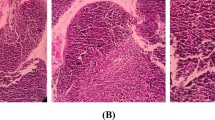Abstract
The effects of aldicarb (a carbamate insecticide and nematocide) on selected immune and non-immune parameters of mice were examined. The primary objective was to determine whether exposure to low levels of aldicarb through drinking water could affect selected immune functions. Aldicarb was administered via drinking water either at 10, 100, and 1,000 parts per billion (ppb)2 for 14 days or at 1, 10, 100, and 1,000 ppb for 34 days. The 34-day experiment was repeated twice with minor variations. Aldicarb significantly and repeatedly suppressed the splenic plaque forming cell response to sheep red blood cells at the lowest concentrations tested: the 1 ppb level elicited greater suppression of plaque forming cells and other immune factors than did 1,000 ppb of aldicarb. This inverse dose-response represents a dramatic departure from the classic toxicologic dose-response curve, where toxicity increases with increasing dose levels.
Similar content being viewed by others
References
Andrawes NR, Dorough HW, Lindquist DA (1967) Degradation and elimination of Temik® in rats. J Econ Entomol 60:980–988
Barnett JB, Spyker-Cranmer JM, Avery DC, Haberman MA (1980) Immunocompetence over the lifespan of mice exposedin utero to carbofuran or diazinon changes in serum immunoglobulin concentrations. J Environ Pathol Toxicol 4:52–63
Casida JE (1963) Mode of action of carbamates. Ann Rev Entomol 8:39–58
Di Carlo FJ (1976) Oxisuran: a non-cytotoxic, differentially immunosuppression agent. Adv Exp Med Biol 73:467–469
Fan A, Street JC, Nelson RM (1978) Immunosuppression [sic] in mice administered methyl parathion and carbofuran by diet. Toxicol Appl Pharmacol 45:235–243
Food and Agricultural Organization of the United Nations (1980) Pesticide Residues in Foods: 1979 Evaluations, Rome, Italy
Fox AE, Gingold JL, Freedman HH (1973) Inhibition by oxisuran of cell-mediated hypersensitivity by decrease in numbers of specifically sensitized cells. Infect Immun 8:549–555
Gainer JH (1977) Effects of heavy metals and of deficiency of zinc on mortality rates in mice infected with encephalo myocarditis virus. Amer J Vet Res 38:869–872
Gupta M, Basch G, Bandyopodhyay J, Sasmal D, Chatterjee T, Day SD (1982) Hematologie changes produced in mice by Nuvacron® or Furadan®. Toxicology 25:255–260
Harkin JM, Jones FA, Fathulla R, Dzantor EK, O'Neill FJ (1984) Pesticides in groundwater beneath the central sands plains of Wisconsin. Wisconsin Water Resources Center, Technical Report WIS WRC 83–01, pp 3, 24, 26, 42–43
Koran TD, English D, McPherson TA (1982) Association of neutrophil chemiluminescence with microbicidal activity. Clin Immunol Immunopathol 22:259–268
Jackson JA, Chart IS, Sanderson JH, Garner R (1977) Pirimicarb induced immune haemolytic anaemia in dogs. Scand J Haematol 19:260–266
Luster MI, Dean JH, Boorman GA, Dieter MP, Hayes HT (1982) Immune functions in methyl and ethyl carbamate treated mice. Clin Exp. Immunol 50:223–230
Maitlen JC, Powell DM (1982) Persistence of aldicarb in soil relative to the carry-over of residues into crops. J Agric Food Chem 30:589–592
Miles CJ, Delfino JJ (1985) Fate of aldicarb, aldicarb sulfoxide and aldicarb sulfone in Floridan groundwater. J Agric Food Chem 33:455–460
Miller RG, Jr (ed) (1981) Simultaneous Statistical Inference, Springer-Verlag, New York, pp 67–70
Moore TC, Rose JE, Vaughan JH (1979) Metabolic inhibition of plaque-forming cells: Comparison of human rheumatoid-factor-producing cells with mouse anti-sheep erythrocyte-producing cells. Ann Rheum Dis 38:237–241
Olson LJ, Hinsdill RD (1984) Influence of feeding chlorocholine chloride and glyphosine on selected immune parameters in deer mice,Peromyscus maniculatus. Toxicology 30:103–114
Pinto-Machado J (1970) Influence of prenatal administration of busulfan on the postnatal development of mice. Production of a syndrome including hypoplasia of the thymus. Teratology 3:363–369
Porter WP, Hinsdill R, Fairbrother A, Olson LJ, Jaeger J, Yuill T, Bisgard S, Hunter WG, Nolan K (1984) Toxicant-disease-environment interactions with suppression of immune system, growth, and reproduction. Science 224:1014–1017
Renoux G, Guillamin JM, Renoux M (1985). Favorable influence of Imuthiol® on mouse reproductive and immune system of offspring. Am J Reprod Immunol Microbiol 8:101–106
Roitt I (1984) Co-operation between T and B cells. In: Roitt I (ed) Essential Immunology, 5th edition, Blackwell Scientific Publications, Oxford, p 67
Schmidt JN (1983) Effects of the pesticide carbaryl on reproduction of human and simian varicella virus. Infect Immunol 39:1485–1487
Speirs RJ, Takewake T, Bensen RW, Jones JM (1980) Models for assessing the effects of toxicants on immunocompetence of mice. III. Augmentation of IgE antibody response to tetanus toxoid by cyclophosphamide in mice. J Environ Pathol and Toxicol 4-2, 3:383–396
Szondy E, Horbath M, Fust G, Link E, Feher J, Gero S (1978) The effects of clofibrate and pyridinal carbamate on the circulating immune complexes and cellular immune response in experimental artherosclerosis. Atherosclerosis 31:251–157
Tracy JW, Kazaura JW, Webster LT Jr. (1982) Suppression of cell-mediated immune responsesin vivo andin vitro by 1-Thiocarbamoyl-2-Imidazolidinone. Immunopharm 4:187–200
Walker EB, Van Epps DE, Warner NL (1981) Macrophage chemiluminescence. In: Herscowitz HB, Holden HT, Bellant JA, Gaffar AG (eds) Manual of Macrophage Methodology, Marcel Dekker, New York, pp 389–397
Wiltrout RW, Ercegovich CD, Ceglowski WS (1978) Humoral immunity in mice following oral administration of selected pesticides. Bull Environ Contam Toxicol 20:423–431
Wyman JA, Erickson BJ, Goodman WG, Binning LK (1985) Radioimmunoassays for detection of aldicarb and metribuzin in groundwater. Report to USDA National Agricultural Pesticide impact Assessment Program, Washington, DC, 35 pp
Zeakes SJ, Hansen MF, Robel RJ (1981) Increased susceptibility of bobwhites (Colinses virginianus) to histomonas meleagridis after exposure to Sevin® insecticide. Avian Dis 25:981–987
Author information
Authors and Affiliations
Rights and permissions
About this article
Cite this article
Olson, L.J., Erickson, B.J., Hinsdill, R.D. et al. Aldicarb immunomodulation in mice: An inverse dose-response to parts per billion levels in drinking water. Arch. Environ. Contam. Toxicol. 16, 433–439 (1987). https://doi.org/10.1007/BF01055264
Received:
Revised:
Issue Date:
DOI: https://doi.org/10.1007/BF01055264




